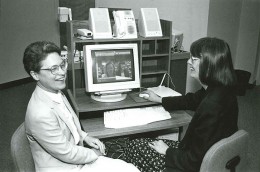By Hannah Franzen
When Kansas State University Global Campus — then the Division of Continuing Education — was established in 1966, online classes were decades from development. Back when technology took up an entire room and personal computers were barely entering the scene, the technological landscape was changing drastically.
Over the past 50 years, as new technologies have become an integral part of our world, K-State Global Campus has used the changing tools of the times to deliver distance education. Although the way classes are delivered has changed — from face-to-face delivery, to broadcast communications, to the interactive online classroom of today — these technologies connect K-State to students and to each other around the world.
1960s: The Kansas Board of Regents established the K-State Division of Continuing Education, now K-State Global Campus, in 1966. In the late 1960s, K-State instructors rented state cars, drove to Kansas towns and taught on location. This face-to-face delivery by driving was nicknamed “windshield time.”
 1970: TELENET, an audioconference network with site locations throughout Kansas, was established by the Kansas Regents Network.
1970: TELENET, an audioconference network with site locations throughout Kansas, was established by the Kansas Regents Network.
1973: A course including 20 written lectures, titled “America and the Future of Man,” was distributed via the newspaper. An article about newspaper course delivery stated, “A student studies this unique course in his own home and at his own pace.”
1984: Telecourses aired on public television. PBS programming ran course content on TV, with students tuning in at certain dates and times to view the course series as it aired. Among the most popular topics was a course series on Vietnam.
 1990s: TELENET 2 launched, providing videoconferencing services for distance delivery and communication throughout Kansas.
1990s: TELENET 2 launched, providing videoconferencing services for distance delivery and communication throughout Kansas.
1996: K-State launched its first online course and online degree program. Grant funding led to the development a distance dietetics degree program.
1998: The university launched its course management system, K-State Online.
 2000s: Course materials were recorded on VHS tapes and mailed to students, later switching to CD-ROM or online delivery.
2000s: Course materials were recorded on VHS tapes and mailed to students, later switching to CD-ROM or online delivery.
2004: K-State reached a milestone of delivering courses to distance students in all 50 states and in 10 countries.
 Today: Online courses use social media sites, wikis, video/interactive content and other technological tools to connect and facilitate learning, collaboration and communication. More courses with shorter, accelerated schedules help meet adult learner needs and align with trends in continuing higher education.
Today: Online courses use social media sites, wikis, video/interactive content and other technological tools to connect and facilitate learning, collaboration and communication. More courses with shorter, accelerated schedules help meet adult learner needs and align with trends in continuing higher education.
As technologies continue to grow and evolve over the next 50 years — or even the next few years — so will the way K-State delivers education to students and professionals worldwide. The next game-changing educational technology could happen any moment.
VIEW THE TIMELINE
See a complete K-State Global Campus history timeline at global.k-state.edu/50/history/timeline.